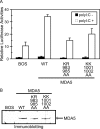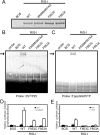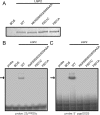Solution structures of cytosolic RNA sensor MDA5 and LGP2 C-terminal domains: identification of the RNA recognition loop in RIG-I-like receptors
- PMID: 19380577
- PMCID: PMC2719387
- DOI: 10.1074/jbc.M109.007179
Solution structures of cytosolic RNA sensor MDA5 and LGP2 C-terminal domains: identification of the RNA recognition loop in RIG-I-like receptors
Abstract
The RIG-I like receptor (RLR) comprises three homologues: RIG-I (retinoic acid-inducible gene I), MDA5 (melanoma differentiation-associated gene 5), and LGP2 (laboratory of genetics and physiology 2). Each RLR senses different viral infections by recognizing replicating viral RNA in the cytoplasm. The RLR contains a conserved C-terminal domain (CTD), which is responsible for the binding specificity to the viral RNAs, including double-stranded RNA (dsRNA) and 5'-triphosphated single-stranded RNA (5'ppp-ssRNA). Here, the solution structures of the MDA5 and LGP2 CTD domains were solved by NMR and compared with those of RIG-I CTD. The CTD domains each have a similar fold and a similar basic surface but there is the distinct structural feature of a RNA binding loop; The LGP2 and RIG-I CTD domains have a large basic surface, one bank of which is formed by the RNA binding loop. MDA5 also has a large basic surface that is extensively flat due to open conformation of the RNA binding loop. The NMR chemical shift perturbation study showed that dsRNA and 5'ppp-ssRNA are bound to the basic surface of LGP2 CTD, whereas dsRNA is bound to the basic surface of MDA5 CTD but much more weakly, indicating that the conformation of the RNA binding loop is responsible for the sensitivity to dsRNA and 5'ppp-ssRNA. Mutation study of the basic surface and the RNA binding loop supports the conclusion from the structure studies. Thus, the CTD is responsible for the binding affinity to the viral RNAs.
Figures







Similar articles
-
Structural basis of double-stranded RNA recognition by the RIG-I like receptor MDA5.Arch Biochem Biophys. 2009 Aug 1;488(1):23-33. doi: 10.1016/j.abb.2009.06.008. Epub 2009 Jun 14. Arch Biochem Biophys. 2009. PMID: 19531363
-
The regulatory domain of the RIG-I family ATPase LGP2 senses double-stranded RNA.Nucleic Acids Res. 2009 Apr;37(6):2014-25. doi: 10.1093/nar/gkp059. Epub 2009 Feb 10. Nucleic Acids Res. 2009. PMID: 19208642 Free PMC article.
-
The RIG-I-like receptor LGP2 recognizes the termini of double-stranded RNA.J Biol Chem. 2009 May 15;284(20):13881-13891. doi: 10.1074/jbc.M900818200. Epub 2009 Mar 11. J Biol Chem. 2009. PMID: 19278996 Free PMC article.
-
Proofreading mechanisms of the innate immune receptor RIG-I: distinguishing self and viral RNA.Biochem Soc Trans. 2024 Jun 26;52(3):1131-1148. doi: 10.1042/BST20230724. Biochem Soc Trans. 2024. PMID: 38884803 Free PMC article. Review.
-
LGP2 synergy with MDA5 in RLR-mediated RNA recognition and antiviral signaling.Cytokine. 2015 Aug;74(2):198-206. doi: 10.1016/j.cyto.2015.02.010. Epub 2015 Mar 18. Cytokine. 2015. PMID: 25794939 Free PMC article. Review.
Cited by
-
Chicken MDA5 senses short double-stranded RNA with implications for antiviral response against avian influenza viruses in chicken.J Innate Immun. 2014;6(1):58-71. doi: 10.1159/000351583. Epub 2013 Jul 13. J Innate Immun. 2014. PMID: 23860388 Free PMC article.
-
Pattern Recognition and Signaling Mechanisms of RIG-I and MDA5.Front Immunol. 2014 Jul 23;5:342. doi: 10.3389/fimmu.2014.00342. eCollection 2014. Front Immunol. 2014. PMID: 25101084 Free PMC article. Review.
-
Control of Innate Immune Activation by Severe Acute Respiratory Syndrome Coronavirus 2 and Other Coronaviruses.J Interferon Cytokine Res. 2021 Jun;41(6):205-219. doi: 10.1089/jir.2021.0060. J Interferon Cytokine Res. 2021. PMID: 34161170 Free PMC article. Review.
-
Severe viral respiratory infections in children with IFIH1 loss-of-function mutations.Proc Natl Acad Sci U S A. 2017 Aug 1;114(31):8342-8347. doi: 10.1073/pnas.1704259114. Epub 2017 Jul 17. Proc Natl Acad Sci U S A. 2017. PMID: 28716935 Free PMC article.
-
Ancient origins of vertebrate-specific innate antiviral immunity.Mol Biol Evol. 2014 Jan;31(1):140-53. doi: 10.1093/molbev/mst184. Epub 2013 Oct 8. Mol Biol Evol. 2014. PMID: 24109602 Free PMC article.
References
-
- Akira S., Uematsu S., Takeuchi O. ( 2006) Cell 124, 783– 801 - PubMed
-
- Yoneyama M., Kikuchi M., Natsukawa T., Shinobu N., Imaizumi T., Miyagishi M., Taira K., Akira S., Fujita T. ( 2004) Nat. Immunol. 5, 730– 737 - PubMed
-
- Hornung V., Ellegast J., Kim S., Brzózka K., Jung A., Kato H., Poeck H., Akira S., Conzelmann K. K., Schlee M., Endres S., Hartmann G. ( 2006) Science 314, 994– 997 - PubMed
-
- Pichlmair A., Schulz O., Tan C. P., Näslund T. I., Liljeström P., Weber F., Reis E., Sousa C. ( 2006) Science 314, 997– 1001 - PubMed
-
- Kato H., Takeuchi O., Sato S., Yoneyama M., Yamamoto M., Matsui K., Uematsu S., Jung A., Kawai T., Ishii K. J., Yamaguchi O., Otsu K., Tsujimura T., Koh C. S., Reis e Sousa C., Matsuura Y., Fujita T., Akira S. ( 2006) Nature 441, 101– 105 - PubMed
Publication types
MeSH terms
Substances
Associated data
- Actions
- Actions
LinkOut - more resources
Full Text Sources
Other Literature Sources
Molecular Biology Databases

